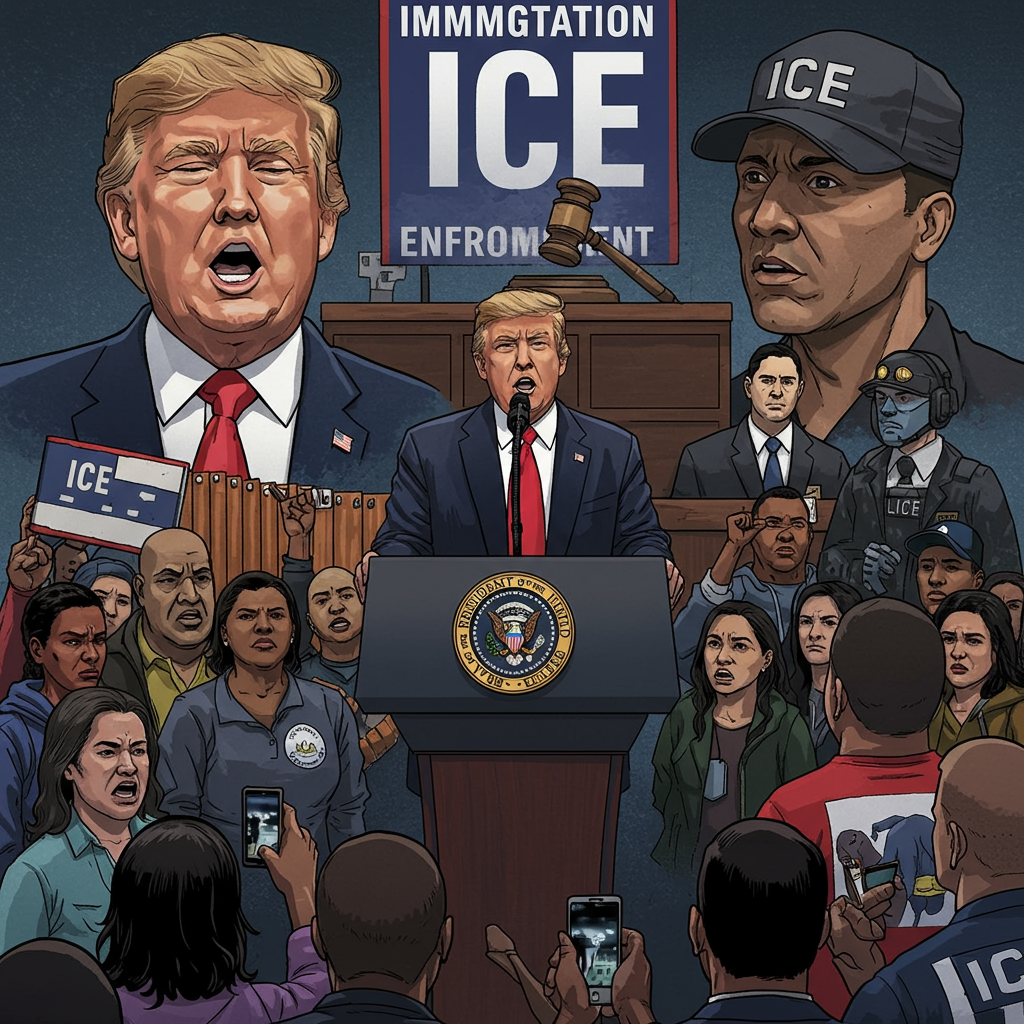During his campaign, Donald Trump made a clear promise: to launch the largest deportation program targeting criminals in U.S. history. This stance resonated with many Americans, including some legal immigrants concerned about illegal entry.
However, since taking office, the Trump administration significantly expanded the scope of its immigration enforcement. While initially emphasizing the pursuit of criminals and public safety threats, the focus widened to target migrant workers, students, tourists with visa issues, and even individuals with clean records. This intensified interior enforcement by Immigration and Customs Enforcement (ICE) agents led to a significant surge in arrests and detention numbers nationwide, often sparking protests, notably in Los Angeles.
Expanding Scope of Enforcement
The shift under the Trump administration marked a change in enforcement strategy. While apprehensions at the Southern Border saw a decrease in some periods, the proportion of individuals arrested by ICE within the United States more than doubled. This led to increased occupancy in immigration detention facilities, reaching highs not seen in years. As of mid-2019, approximately 51,000 undocumented migrants were in ICE detention, a record high at that time.
White House officials expressed a desire to dramatically increase the pace of arrests, aiming for thousands per day. While the administration initially insisted operations were “targeted,” data compiled by projects like the Transactional Records Access Clearinghouse (TRAC) at Syracuse University indicated that a significant percentage of detainees had no criminal record other than immigration violations. For instance, around 44% of those in ICE detention facilities in June 2019 reportedly lacked criminal histories beyond entering the country without permission.
Who Was Targeted?
ICE operations under the Trump administration impacted a diverse group of individuals:
Undocumented Immigrants: While some individuals arrested had criminal histories, many others detained had clean records, being targeted simply for being in the country without authorization. Officials sometimes justified these arrests of non-criminals as “collateral” damage, arguing agents could not overlook undocumented individuals encountered during operations.
Tourists and Visitors: Several foreign nationals visiting the U.S. were detained due to visa complications. This included a British tourist held for 19 days over a visa mix-up, Italian TikTok star Khaby Lame briefly detained for an alleged overstay, and a Canadian actress held for nearly two weeks at the border while attempting to renew her visa, describing harsh detention conditions before being released without charges. A German national who had lived in the U.S. for years was also detained and questioned about old, dismissed charges upon returning from abroad.
‘Alien Enemies’: In a striking move, the administration used a rarely invoked 1798 act to label some individuals as “alien enemies,” allowing sweeping powers for detention and deportation of natives of an “enemy” nation. This approach was reportedly used in El Salvador, with over 250 people alleged to be gang members transferred to a mega-prison, though some families disputed gang ties. A high-profile case involved Kilmar Abrego Garcia, an El Salvadoran resident deported despite court rulings calling his removal erroneous; he was later returned to face unrelated federal charges. Advocacy groups criticized these actions as inhumane and potentially illegal.
Student Protesters: Foreign nationals, including those with permanent residency or valid student visas, were targeted after participating in political protests, particularly on college campuses. Over 1,600 international student visas were reportedly revoked. Examples include a green card holder fighting deportation after participating in Gaza war protests at Columbia University and a Tufts University student whose visa was revoked after similar protests. While ICE justified some such arrests by claiming participants were “aligned” with designated groups, officials also stated that visas are privileges, not rights.
Protests and Political Pushback
The intensified ICE operations, including workplace raids, sparked significant protests in various cities, especially Los Angeles. Demonstrations in LA escalated into clashes between protesters and law enforcement, involving blocked freeways, vandalism, and objects thrown at officers. In response, President Trump deployed federal assets, including National Guard troops and U.S. Marines, to Los Angeles.
This federal deployment, made without the consent of California officials, drew sharp criticism. Governor Gavin Newsom and Mayor Karen Bass opposed the move, arguing it could escalate tensions and that California authorities had the situation under control. Governor Newsom filed a lawsuit challenging the federalization of the National Guard, while Mayor Bass implemented curfews to address vandalism and looting during the protests. Law enforcement, including the LAPD, made numerous arrests during the demonstrations, charging individuals with offenses ranging from assault on officers to burglary and vandalism. LAPD officials noted the complexities introduced by California’s sanctuary state law (SB 54), which limits their ability to assist federal immigration enforcement.
Administration’s Stance and Challenges
Despite the criticism and protests, Trump administration officials, such as Tom Homan, the “border czar” at the time, asserted that immigration law enforcement would continue daily, regardless of opposition. Homan warned against interfering with federal agents, even suggesting elected officials could face felony charges for harboring individuals illegally present or impeding duties. He maintained that while prioritizing public safety threats, anyone in the country illegally was “not off the table” for deportation, denying claims that agents targeted sensitive locations like schools or hospitals. Homan was also a vocal critic of California’s sanctuary policies, arguing they compromised public safety.
While interior ICE arrests surged, increasing deportations faced challenges, including finding countries willing to accept returnees. The administration explored sending migrants to unconventional locations like a prison in El Salvador or the U.S. military base at Guantánamo Bay. They also requested substantial funding increases for enforcement and deportations and promoted “self-deportation” through incentives like financial assistance for voluntary returns. Despite efforts to accelerate the pace, achieving the administration’s ambitious deportation targets proved complex.




